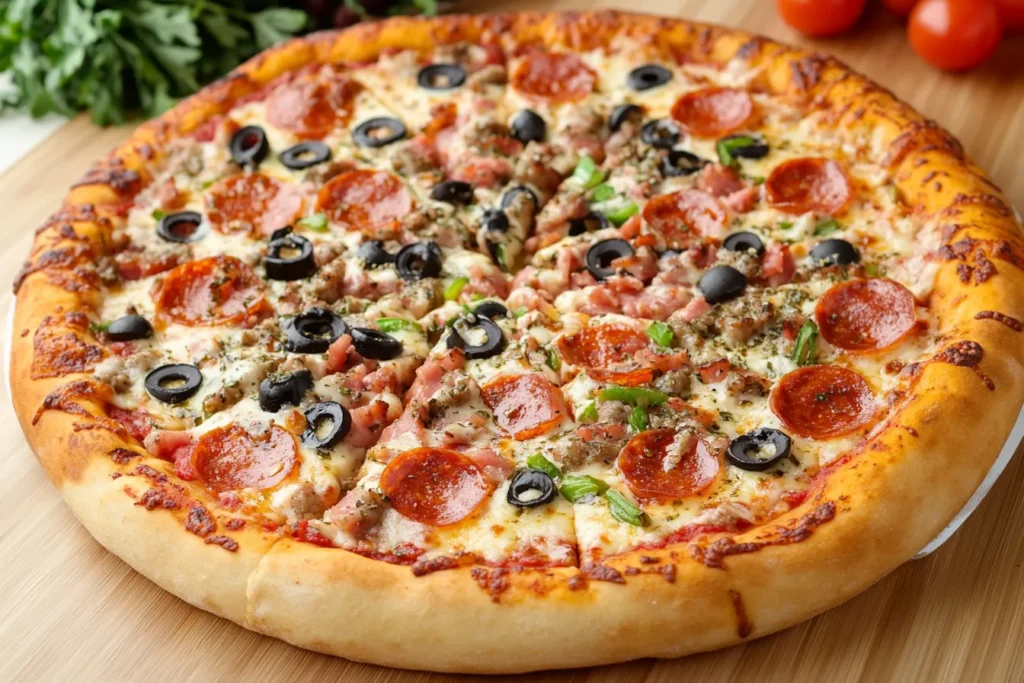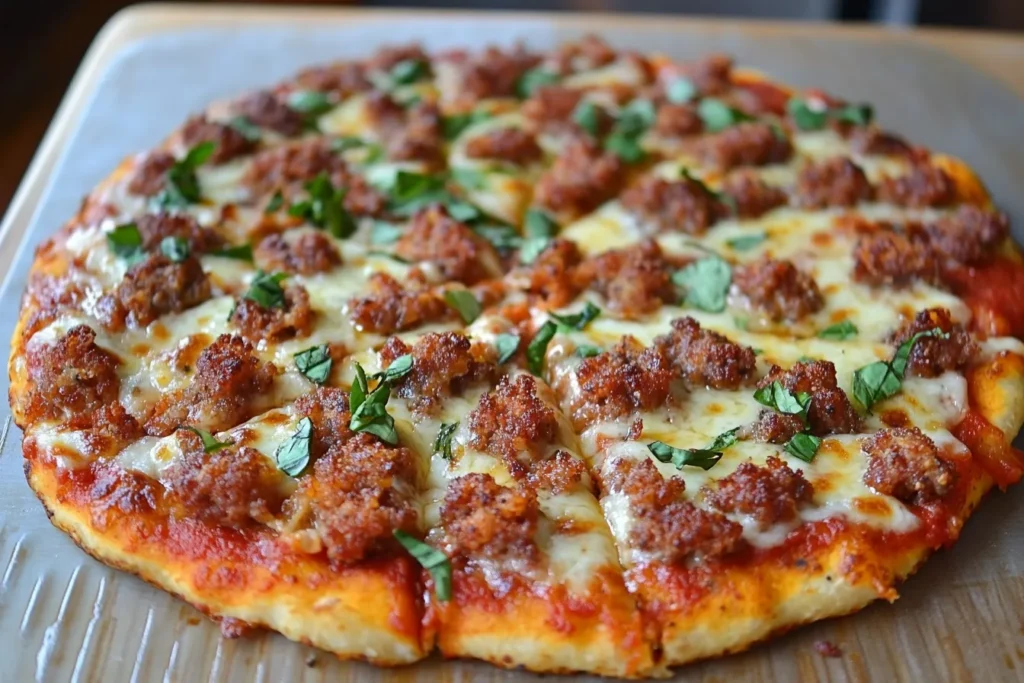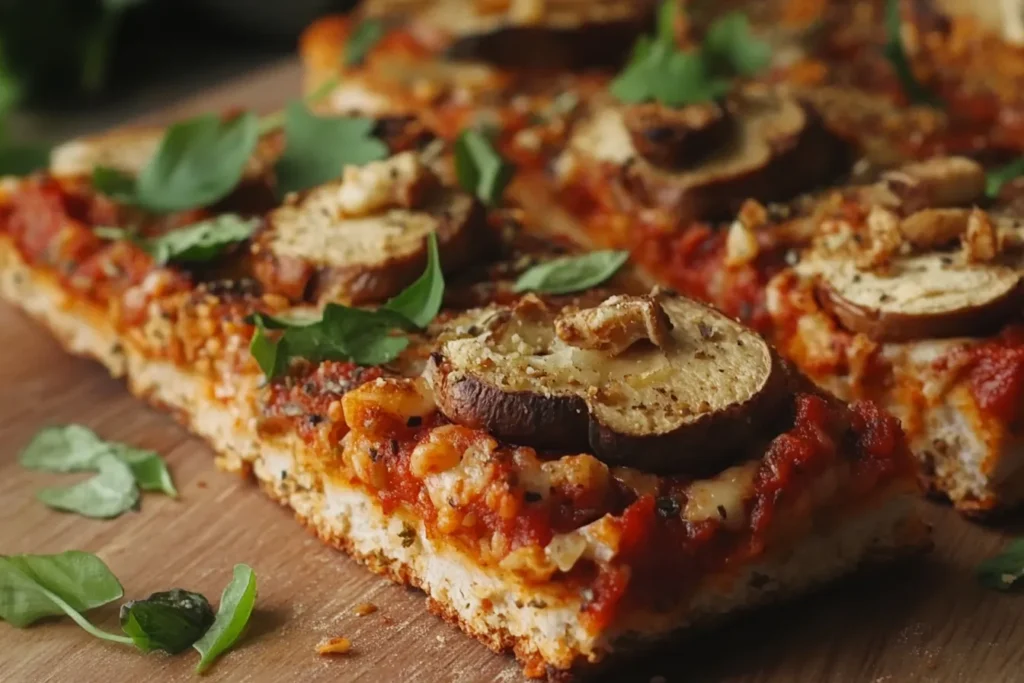Have you ever struggled to find food that satisfies your cravings while meeting your dietary needs? If gluten has been holding you back from enjoying some of your favorite meals, you’re not alone. The good news is, you don’t have to give up flavor, texture, or variety—especially when it comes to pizza. Whether you’re avoiding gluten for health reasons or exploring new food options, this guide will show you how to enjoy delicious, gluten-free pizza that hits all the right notes. Get ready to rediscover the joy of pizza without compromise!
List Of Contents
Introduction to Gluten-Free Pizza
In recent years, gluten-free pizza has gained immense popularity, becoming a staple in health-conscious diets around the globe. What was once a niche product aimed at individuals with celiac disease is now a mainstream choice for those seeking better digestion and improved well-being. The rise of gluten-free alternatives is fueled by growing awareness about food sensitivities and their impact on overall health.
Whether you’re at a local pizzeria or a high-end restaurant, gluten-free options are no longer an afterthought—they’re often celebrated on the menu. This trend reflects a shift in consumer preferences toward healthier eating, with a particular emphasis on gluten-free lifestyles. check out more recipes here.

What Is Gluten?
To understand why gluten-free pizza is healthier, it’s essential to know what gluten is. Gluten refers to a group of proteins commonly found in wheat, barley, and rye. It acts as a binding agent, giving traditional pizza dough its elasticity and chewy texture. While gluten provides structural benefits, it can also trigger adverse reactions in some individuals.
For people with celiac disease, gluten consumption leads to damage in the small intestine, resulting in malabsorption of nutrients. Even those without celiac disease may experience gluten sensitivity, manifesting as bloating, fatigue, and other symptoms. This has led to a surge in gluten-free alternatives like pizza bases made from non-gluten flours. check out more recipes here.
What Is Gluten-Free Pizza?
Gluten-free pizza is a variant of traditional pizza, crafted without wheat-based flour. Instead, ingredients like rice flour, almond flour, or cauliflower are used to create a base that mimics the texture of regular dough. Unlike traditional pizza, which relies heavily on gluten for its structure, gluten-free pizza uses innovative combinations of ingredients to achieve the desired consistency.
This alternative not only caters to those with gluten intolerance but also attracts health enthusiasts who prefer lighter, nutrient-dense meals. For instance, cauliflower crusts are lower in carbs and calories, making them ideal for weight management. check out more recipes here.
Who Benefits from Gluten-Free Pizza?
The primary beneficiaries of gluten-free pizza are individuals with celiac disease and gluten intolerance. However, the appeal extends far beyond these groups. Many choose gluten-free pizza as part of a lifestyle shift toward cleaner eating.
- Celiac Disease: Gluten-free pizza is essential for avoiding severe digestive issues and malabsorption.
- Gluten Sensitivity: Even without celiac disease, some experience symptoms like bloating and fatigue from gluten consumption.
- Health-Conscious Consumers: Many believe gluten-free pizza is a lighter, healthier alternative to regular pizza.
Common Misconceptions About Gluten-Free Pizza
There are numerous myths surrounding gluten-free pizza. One common misconception is that it lacks flavor and texture compared to regular pizza. In reality, advancements in recipes and ingredients have made gluten-free pizzas just as enjoyable, if not more so, than their traditional counterparts.
Another misconception is that gluten-free automatically means healthier in every situation. Although gluten-free pizzas can be healthier when made with quality ingredients, not all gluten-free options are low in calories or rich in nutrients. check out more recipes here.
Nutritional Composition of Gluten-Free Pizza
The nutritional profile of gluten-free pizza depends on the ingredients used. Bases like cauliflower or almond flour tend to be higher in fiber and lower in carbs than wheat-based crusts. Additionally, gluten-free pizzas often incorporate healthier oils and minimal preservatives.
Key nutrients include:
- Vitamins and Minerals: Calcium and iron from almond-based crusts.
- Low Glycemic Index: Helps manage blood sugar levels.
The Science Behind Gluten-Free Benefits
Scientific research supports the idea that avoiding gluten can improve digestive health. For individuals with gluten sensitivities, reducing gluten intake alleviates symptoms like bloating and indigestion. Moreover, gluten-free diets have been linked to reduced inflammation, which can help manage chronic conditions such as arthritis. check out more recipes here.
Comparison Between Regular and Gluten-Free Pizza
Traditional pizza often relies on enriched wheat flour, which lacks essential nutrients due to processing. In contrast, gluten-free pizzas prioritize whole, minimally processed ingredients. Here’s a quick comparison:
- Regular Pizza: High in refined carbs, which may lead to energy crashes.
- Gluten-Free Pizza: Made from nutrient-dense flours with a lower glycemic impact.
Popular Bases Used in Gluten-Free Pizza
Gluten-free pizza bases are made from a variety of ingredients, each offering unique health benefits:
- Cauliflower Crust: Low in carbs, rich in antioxidants.
- Almond Flour Crust: High in protein and healthy fats.
- Chickpea Flour: Packed with fiber and protein.
Rising Demand for Gluten-Free Pizza
The demand for gluten-free pizza is skyrocketing, driven by both health trends and greater accessibility. Major pizza chains and artisanal pizzerias alike now offer gluten-free options, catering to a diverse consumer base. According to recent market reports, the global gluten-free product market is expected to grow significantly in the coming years, underscoring the lasting popularity of these alternatives.
Health Benefits of Gluten-Free Pizza
One of the most significant advantages of gluten-free pizza is its impact on digestive health. For individuals with celiac disease or gluten intolerance, consuming gluten triggers uncomfortable symptoms such as bloating, diarrhea, and abdominal pain. By choosing gluten-free options, these symptoms can be alleviated, allowing the digestive system to function optimally.
Even for those without specific gluten sensitivities, gluten-free pizza can be easier to digest due to the absence of heavily processed wheat flour. Bases made from ingredients like cauliflower or almond flour are rich in fiber, which supports healthy bowel movements and promotes gut health.
Reduced Inflammation
A gluten-free diet has been shown to reduce inflammation, particularly in individuals who are sensitive to gluten. Chronic inflammation is linked to several serious health conditions, including arthritis, cardiovascular disease, and autoimmune disorders. Gluten-free pizza, often crafted from anti-inflammatory ingredients like almond flour or flaxseed, may help minimize these risks.
Furthermore, incorporating nutrient-dense toppings such as spinach, tomatoes, and olive oil enhances the anti-inflammatory properties of the meal, making it a smart choice for those aiming to reduce systemic inflammation.
Weight Management
Switching to gluten-free pizza can support weight management goals, especially when compared to traditional pizza. Many gluten-free bases, such as those made from cauliflower or chickpea flour, are lower in carbohydrates and calories. These alternatives also have a lower glycemic index, which helps prevent sudden blood sugar spikes and crashes.

For example:
- A traditional pizza slice may contain up to 300 calories.
- A cauliflower-based gluten-free pizza slice might only have 150-200 calories, depending on the toppings.
By opting for gluten-free pizza, individuals can enjoy their favorite comfort food while sticking to calorie-conscious diets.
Improved Energy Levels
Many individuals claim to feel more energized after switching to a gluten-free diet. Gluten sensitivity can lead to fatigue due to the inflammation and digestive stress caused by gluten consumption. By eliminating this trigger, the body can absorb nutrients more effectively, leading to increased energy levels.
Gluten-free pizza, especially when topped with fresh vegetables and lean proteins, provides a steady source of clean energy. Unlike traditional pizza, which often leads to post-meal sluggishness, gluten-free alternatives leave you feeling satisfied but light.
Gluten-Free Pizza and Skin Health
Did you know that gluten-free pizza could also contribute to clearer skin? For some individuals, gluten consumption has been linked to skin conditions such as acne, eczema, and psoriasis. Eliminating gluten can reduce these flare-ups, promoting a healthier complexion.
Additionally, the nutrient-rich bases and toppings of gluten-free pizza supply skin-boosting vitamins like Vitamin E, which is found in almond flour, and Vitamin C, commonly found in vegetables used as toppings.
Lower Risk of Chronic Diseases
Regularly consuming gluten-free pizza as part of a balanced diet may lower the risk of developing chronic diseases. Refined wheat-based products are often linked to conditions such as type 2 diabetes and heart disease due to their high glycemic index. Gluten-free alternatives, particularly those made from whole-food ingredients, stabilize blood sugar levels and reduce harmful cholesterol.
For instance:
- Almond flour is rich in healthy fats that support heart health.
- Cauliflower is known for its antioxidant properties, which combat oxidative stress.
Allergen-Friendly Options
Gluten-free pizza is an excellent choice for individuals with multiple food allergies. Beyond avoiding gluten, many recipes and store-bought options are free from other common allergens, such as dairy and eggs. This makes it a versatile option for families with diverse dietary needs or for those following vegan and paleo diets.
Psychological Benefits
The benefits of gluten-free pizza are not just physical—they’re psychological as well. For those with gluten sensitivity, eating gluten can trigger symptoms like brain fog, anxiety, and irritability. Avoiding gluten by choosing gluten-free options can improve mental clarity and mood.
Furthermore, the peace of mind that comes from enjoying a safe and delicious meal without worrying about adverse reactions adds to the overall dining experience.
Tailored Nutrition
One of the key benefits of gluten-free pizza is the ability to customize its nutritional profile. Many gluten-free recipes allow you to control the ingredients, ensuring you get a meal that suits your dietary preferences and goals. For instance, you can:
- Opt for a high-protein base using chickpea or almond flour.
- Add nutrient-rich toppings like kale, mushrooms, and grilled chicken.
This level of personalization is often harder to achieve with pre-made traditional pizzas, which rely heavily on standardized ingredients.
Gluten-Free Pizza for Athletes
Athletes often turn to gluten-free diets to improve performance and recovery. For those with undiagnosed gluten sensitivities, eating gluten can lead to inflammation and slow muscle repair. Gluten-free pizza provides a nutritious and satisfying meal that aids in post-workout recovery without triggering inflammation.
Protein-packed bases like chickpea flour or quinoa, paired with lean meats and fresh veggies, make gluten-free pizza a powerhouse meal for fitness enthusiasts.
How to Choose a Quality Gluten-Free Pizza
Selecting a high-quality gluten-free pizza can be a daunting task with so many options on the market. Here are some tips to ensure you pick the healthiest and tastiest option:
- Check the Ingredients: Look for pizzas made with whole, minimally processed ingredients like almond flour, cauliflower, or chickpea flour. Avoid those with excessive additives or preservatives.
- Examine the Nutritional Label: Opt for options that are low in refined carbs and sugar but high in fiber and protein.
- Avoid Cross-Contamination: If you have celiac disease, ensure the pizza is prepared in a gluten-free certified facility to prevent contamination.
Brands like Against the Grain and Cali’flour Foods are known for offering reliable and high-quality gluten-free options.
Common Mistakes in Making Gluten-Free Pizza
Preparing gluten-free pizza at home can be rewarding, but it’s not without challenges. Avoid these common mistakes:
- Overcomplicating the Dough: Gluten-free dough can be tricky to work with, so stick to simple recipes that use tried-and-tested ingredients.
- Skipping Rest Time: Gluten-free dough often needs extra time to hydrate properly, so don’t rush the process.
- Using the Wrong Tools: A pizza stone or cast-iron skillet can make a significant difference in achieving a crispy crust.
Best Gluten-Free Pizza Recipes
Homemade gluten-free pizza allows you to control every ingredient for maximum flavor and nutrition. Here’s an easy recipe for making a cauliflower crust pizza:

Ingredients:
- 1 medium head of cauliflower, grated.
- 1 egg.
- 1/4 cup grated Parmesan cheese.
- 1/2 cup shredded mozzarella cheese.
- 1 tsp Italian seasoning.
Instructions:
- Preheat your oven to 400°F (200°C).
- Microwave the grated cauliflower for 4-5 minutes, then squeeze out excess water.
- Mix the cauliflower with egg, cheeses, and seasoning.
- Shape the mixture into a pizza crust on parchment paper and bake for 15 minutes.
- Top with your favorite ingredients and bake for an additional 10 minutes.
Top Gluten-Free Pizza Brand
For those who prefer store-bought convenience, several brands stand out for their delicious and nutritious offerings:
- Udi’s Gluten-Free: Known for their classic-style crusts.
- Simple Mills: Offers almond flour-based pizzas with clean ingredients.
- Cappello’s: Specializes in grain-free, high-protein pizzas.
Restaurant Gluten-Free Pizza Choices
When dining out, look for restaurants that take gluten-free seriously. Chains like Blaze Pizza and MOD Pizza offer gluten-free crusts, but always inquire about cross-contamination practices. For a more gourmet experience, many local pizzerias now feature specialty gluten-free options.
Affordable Gluten-Free Pizza Options
Gluten-free options can sometimes come with a hefty price tag. To enjoy affordable gluten-free pizza:
- Make It at Home: Bulk buy ingredients like almond flour or chickpea flour to save money.
- Look for Discounts: Check for deals at health food stores or online retailers like Thrive Market.
- Frozen Options: Brands like Trader Joe’s offer budget-friendly gluten-free frozen pizzas.
Innovations in Gluten-Free Pizza Baking
The world of gluten-free pizza baking has seen significant advancements, from new flour blends to innovative cooking techniques:
- Cassava Flour: A versatile, grain-free flour gaining popularity for its elasticity.
- Prebiotic Ingredients: Enhancing gut health by incorporating prebiotic-rich bases.
- High-Protein Crusts: Using ingredients like lentils or quinoa to create more nutritious options.
These innovations continue to make gluten-free pizza a tastier and healthier choice for everyone.
Gluten-Free Pizza Pairings
The right toppings and sides can elevate your gluten-free pizza experience. Consider:
- Toppings: Fresh vegetables like spinach and artichokes, lean proteins like grilled chicken, and healthy fats like avocado or olive oil.
- Sides: Pair your pizza with a fresh side salad or roasted vegetables for a well-rounded meal.
How to Store Gluten-Free Pizza
Proper storage ensures your gluten-free pizza retains its freshness and flavor:
- Refrigeration: Keep leftovers in an airtight container and store them for up to 3 days.
- Freezing: Pre-bake crusts and freeze them for quick assembly later.
- Reheating: Use an oven or air fryer to maintain crispness when reheating.
Future of Gluten-Free Pizza
The future of gluten-free pizza is bright, with continuous innovations shaping the market. Trends to watch include:
- Sustainability: Eco-friendly and locally sourced ingredients becoming more prevalent.
- Personalized Nutrition: Customizable gluten-free pizzas tailored to individual dietary needs.
- New Flavors: Experimentation with global cuisines to create unique gluten-free pizzas, such as turmeric-infused crusts or spicy harissa toppings.
As awareness of gluten sensitivity grows, the demand for creative and nutritious gluten-free options will only increase.
